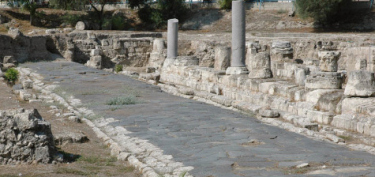The undefeated Grecian military leader Alexander the Great traveled through Tarsus with his massive army in 333 B.C. Alexander almost met his demise in the city after he had taken a bath in Cydnus.
Pompey, the great Roman military general, placed Tarsus under the control of Rome. It soon became the capital city of Cilicia (the province in which the city existed) and the place where the province's governor lived. The city was given the status of being "free" by Roman Emperor Augustus as a thanks for its efforts during Rome's civil wars.
Free cities in the Roman empire were allowed to govern themselves by their own laws and customs, and given the privelage of selecting their own magistrates. Such free cities like Tarsus were also not subject to having Roman guards stationed within its gates.

Those born in such free cities (like the Apostle Paul) were deemed to be citizens of the Roman Empire and could therefore exercise the privileges and rights granted to those with a Rome-based citizenship.
Tarsus was also the place where Egyptian Queen Cleopatra and Mark Antony met for the first time and where they held celebrated feasts during the construction of their fleet (41 B.C.). It was well-known for its culture of Greek philosophy, literature and wealth. Its schools of learning rivaled and excelled even those found in Athens and Alexandria. Around 171 B.C. the city's library held 200,000 books, including a huge collection of scientific works.
The Apostle's Hometown
The New Testament references the apostle Paul in relation to his hometown of Tarsus several times (Acts 9:11, 30, 11:25, 21:39, 22:3). The Life and Epistles of Paul by Conybeare and Howson states the following regarding the apostle's place of birth.
"Situated near the western border of the Cilician plain, where the river Cydnus flows in a cold and rapid stream, from the snows of Taurus to the sea, was the city of Tarsus, the capital of the whole province, and "no mean city" (Acts 21:39) in the history of the ancient world.
"Its (Tarsus') coins reveal to us its greatness through a long series of years:- alike in the period which intervened between Xerxes and Alexander, - and under the Roman sway, when it exulted in the name of Metropolis, - and long after Hadrian had rebuilt it, and issued his new coinage with the old mythological types . . .
"Strabo says that, in all that relates to philosophy and general education, it (the city) was even more illustrious than Athens and Alexandria. From his description it is evident that its main character was that of a Greek city, where the Greek language was spoken, and Greek literature studiously cultivated.
"But we should be wrong in supposing that the general population of the province was of Greek origin, or spoke the Greek tongue. When Cyrus came with his army from the Western Coast, and still later, when Alexander penetrated into Cilicia, they found the inhabitants "Barbarians." (chapter 1, section "Tarsus and Cicero").
Paul's reference to the place of his birth and the Roman citizenship it made possible helped him avoid being whipped by the Romans (Acts 22:22 - 29).
The Apostle Paul also used his rights of citizenship, given to him in Tarsus, when he appealed to have a case against him (started by Jews) be heard in Rome by Caesar himself (Acts 25:10 - 12).